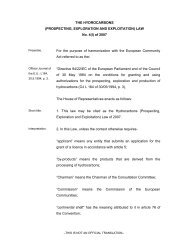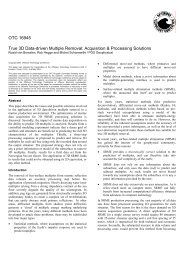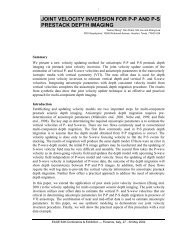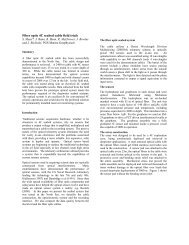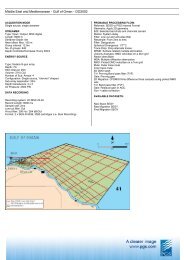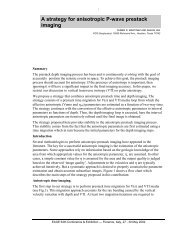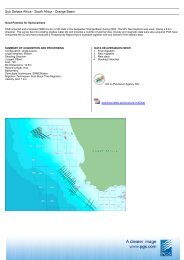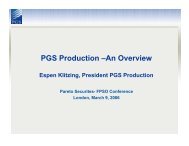Annual Report 2011 - PGS
Annual Report 2011 - PGS
Annual Report 2011 - PGS
Create successful ePaper yourself
Turn your PDF publications into a flip-book with our unique Google optimized e-Paper software.
Operations<br />
in <strong>2011</strong>. The performance figure shows the<br />
relationship between actual fleet survey<br />
production hours and downtime, excluding<br />
standby, unfavorable weather and steaming<br />
time. From 2010 to <strong>2011</strong>, the fleet performance<br />
figure declined slightly.<br />
In order to improve performance, enhance<br />
profitability and cut costs, <strong>PGS</strong> implemented<br />
a profit improvement program in the fourth<br />
quarter of <strong>2011</strong>, targeting a USD 50 million<br />
EBIT run-rate improvement by year-end 2012.<br />
The Operations business unit is responsible<br />
for five components of the profit improvement<br />
program:<br />
JJ<br />
JJ<br />
JJ<br />
JJ<br />
JJ<br />
Yard stays management — tighter control<br />
over costs, quality and duration<br />
General procurement initiatives — focus on<br />
general cost level and vendor count<br />
Reduction of non-productive vessel time<br />
— reexamine overall logistics and betweenproject<br />
activities<br />
Support and chase vessel cost management<br />
— launch initiatives to reduce these<br />
significant cost components of seismic<br />
operations; assess wide-scale fleet renewal<br />
to improve fuel efficiency as well as general<br />
operating efficiency of the support fleet<br />
Reorganizational upgrading —implement<br />
organizational changes that improve<br />
efficiency, safety and control while reducing<br />
expenses.<br />
Ramform Titan-class<br />
In late 2010, <strong>PGS</strong> launched a fleet renewal and<br />
expansion program. Two new Ramform Titanclass<br />
vessels were ordered from Mitsubishi<br />
Heavy Industries Ltd. The vessels will continue<br />
with the proven design advantages of <strong>PGS</strong>’<br />
current Ramform fleet and implement capability<br />
enhancements across several key performance<br />
parameters. Delivery of the first vessel is<br />
scheduled for first quarter 2013, with the second<br />
being delivered in fourth quarter 2013.<br />
Estimated 2012 capital expenditures for the new<br />
builds will amount to approximately USD 200<br />
million out of a project total of some USD 500<br />
million, or USD 250 million per vessel.<br />
The vessels will further strengthen <strong>PGS</strong>’<br />
premier status in the fast growing HD3D market<br />
segment, where a premium seismic data<br />
product is required in order for customers to<br />
gain a solid understanding of the geology and<br />
resource potential of deep targets with complex<br />
structures. For conducting HD3D surveys large<br />
spreads are required, with long offsets and<br />
dense streamer separation. The Ramform Titanclass<br />
vessels are even better suited for these<br />
premium surveys than the existing Ramform fleet.<br />
GeoStreamer Rollout<br />
GeoStreamer is a proprietary, dual sensor<br />
streamer technology unique to <strong>PGS</strong>.<br />
GeoStreamer eliminates the receiver ghost<br />
during acquisition and offers oil companies<br />
better penetration, enhanced resolution,<br />
reduced risk and improved imaging and<br />
attributes. Demand for GeoStreamer acquisition<br />
has surpassed all expectations.<br />
As the search for new oil and gas fields<br />
becomes more difficult, exploration<br />
increasingly targets deeper reservoirs that<br />
present more challenging conditions and<br />
increasingly complex stratigraphic traps that<br />
confound traditional seismic studies.<br />
GeoStreamer technology was commercialized<br />
in 2008 and quickly gained wide acceptance<br />
among oil companies. <strong>PGS</strong> rolled out the new<br />
streamer technology on 2D vessels in 2008 to<br />
prove its benefits to customers. In 2009, <strong>PGS</strong><br />
extended the rollout to 3D operations and the<br />
Atlantic Explorer was the first 3D vessel to have<br />
the new streamer technology installed. In late<br />
2009, Ramform Challenger was equipped with<br />
GeoStreamer to become the Company’s first<br />
high-capacity Ramform vessel to deploy the<br />
advanced streamer technology. Survey and<br />
vessel performance has been excellent since<br />
the conversion to GeoStreamer.<br />
Considerable demand for GeoStreamer surveys<br />
justified an accelerated GeoStreamer rollout in<br />
2010. The Ramform Valiant was upgraded to a<br />
GeoStreamer vessel in the second quarter and<br />
Ramform Explorer followed early in the third<br />
quarter. GeoStreamer rollout continued in <strong>2011</strong>,<br />
with the Ramform Viking in the first quarter and<br />
<strong>PGS</strong> Apollo in the second quarter. The Ramform<br />
Vanguard is scheduled for GeoStreamer<br />
upgrade in 2012.<br />
<strong>PGS</strong> is recognized<br />
throughout the industry<br />
for its unique Ramform<br />
vessels<br />
<strong>PGS</strong> <strong>Annual</strong> <strong>Report</strong> <strong>2011</strong> 29



